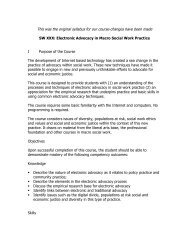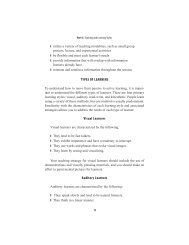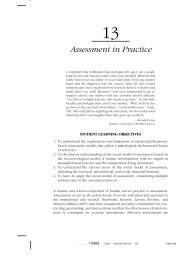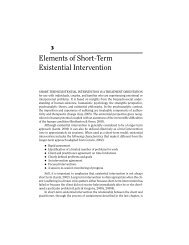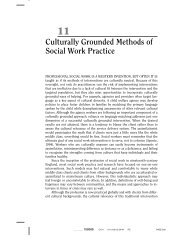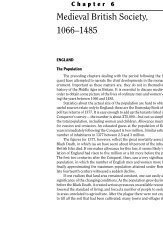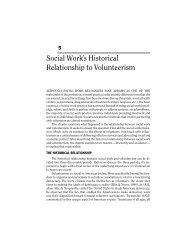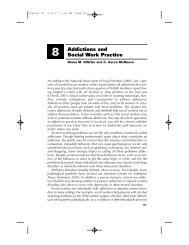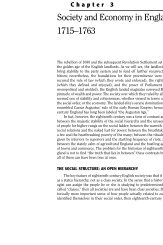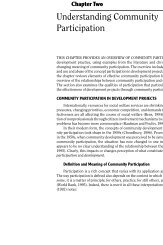Chapter 2 Self-Awareness, Critical Reflectivity, and ... - Lyceum Books
Chapter 2 Self-Awareness, Critical Reflectivity, and ... - Lyceum Books
Chapter 2 Self-Awareness, Critical Reflectivity, and ... - Lyceum Books
Create successful ePaper yourself
Turn your PDF publications into a flip-book with our unique Google optimized e-Paper software.
<strong>Chapter</strong> 02 2/11/08 12:10 PM Page 27<br />
<strong>Self</strong>-<strong>Awareness</strong>, <strong>Critical</strong> <strong>Reflectivity</strong>, <strong>and</strong> Identity 27<br />
tor (Carter, 1993). Racial identity development is not just something people<br />
who are white need to underst<strong>and</strong>; populations that have historically been oppressed<br />
<strong>and</strong> marginalized because of their race must underst<strong>and</strong> the process<br />
as well.Helms’s (1993a) study of racial dyads highlights important implications<br />
for all people’s underst<strong>and</strong>ing of racial identity development. Cognitive, affective,<br />
<strong>and</strong> behavioral issues are likely to influence different mechanisms that<br />
people use for coping with racial issues. The overlap between models of<br />
African American identity development <strong>and</strong> the model of white racial identity<br />
development further elucidates issues of identity, race, <strong>and</strong> racism. Tatum<br />
(2003) points out that all groups of color in the United States face issues regarding<br />
racism <strong>and</strong> as a result grapple with many of the identity development<br />
issues discussed by Helms (1993c), such as balancing the issues of assimilation<br />
into the dominate culture with the need to retain identification with one’s<br />
own culture <strong>and</strong> community.<br />
Racial identity development is neither static nor linear. Not everyone starts<br />
at the same place, nor does everyone progress in a step-by-step manner. The<br />
manner in which one’s racial identity is integrated into her or his personality<br />
depends on several sociocultural factors, such as parents, family, peers, schools,<br />
religious organizations, <strong>and</strong> the media; systemic factors, such as socioeconomic<br />
class,discrimination,<strong>and</strong> quality of interracial interactions;<strong>and</strong> physical <strong>and</strong> personal<br />
attributes (Helms, 1993a).<br />
African American Racial Identity Model<br />
Theories of visible racial/ethnic identity in populations of color have been<br />
a topic of interest for several decades. William E. Cross <strong>and</strong> Janet Helms are<br />
among the leaders in this field of study. The model of racial identity development<br />
for people who are African American was first introduced by Cross (1978,<br />
1980, 1991) <strong>and</strong> was later exp<strong>and</strong>ed by Helms (1984, 1993c, 1994).This model<br />
outlines the path that people who are African American may take in developing<br />
a healthy racial identity. Helms’s (1993c) amended model, which focuses on<br />
one’s worldview, delineates the five stages of racial identity formation: preencounter,<br />
encounter, immersion/emersion, internalization, <strong>and</strong> internalization/<br />
commitment.<br />
During the pre-encounter stage, people who are African American idealize<br />
the worldview of the dominant white culture <strong>and</strong> denigrate blackness <strong>and</strong> black<br />
culture. It is assumed that people who are white hold their advantaged status<br />
because of their extraordinary efforts, <strong>and</strong> that people who are African American<br />
are disadvantaged because they have not exercised enough effort.The person<br />
denies her or his racial identity <strong>and</strong> identifies with people who are white.<br />
During this stage the person attributes her or his success or failure to how well<br />
she or he imitates the traits associated with whiteness (Helms, 1993b).<br />
During the encounter stage, the person becomes aware that race is the<br />
delineator that determines or influences one’s life options. A single event or an



